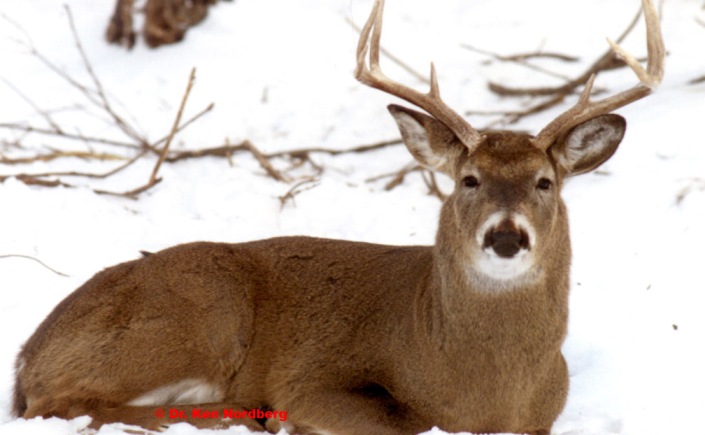My sons and I eventually discovered keeping from being identified by smell by bucks 3-1/2 to 6-1/2 years of age (and other deer) and avoiding the likely consequences is a lot more complicated than we originally envisioned. Today, I believe a whitetail’s nose is its most important organ for survival, its eyes and ears merely providing second opinions. Via a mature (experienced) whitetail’s sense of smell, it can accurately determine how far away an unseen wolf or hunter is, generally ignoring them while 200 yards or more away. Via airborne scents it can determine whether a wolf or human is moving left or right, toward it, away from it or not moving at all (Viola, that long unmoving human I smell is a “stand hunter”). From downwind, a whitetail’s nose can determine whether or not it is safe to enter a feeding area or bedding area. When pursued by a wolf or hunter, a whitetail can use its nose to avoid ambushers ahead. When trailed by a slow-moving pursuer such as a human hunter, by turning downwind it can use its nose to keep track of the pursuer’s progress and maintain a safe distance ahead of it. When caught between standers and drivers during a drive, a mature buck can use its nose to find a safe hideaway between oncoming drivers. The only problem with depending on their sense of smell to survive is, whitetails can only detect odors of wolves or hunters drifting toward them from upwind. They cannot detect danger moving toward them or waiting in ambush from crosswind or downwind. They must then depend on their vision and hearing, senses a knowledgeable and skillful hunter can fool and take advantage of.
Whitetails make daily use of another source of identifying scents, namely trail scents. Trails scents are an intense (by whitetail standards) combination of many odoriferous molecules that fall to the ground from a hunter’s body, clothing, boot soles (especially the strong smell of rubber) and hunting gear, creating a narrow and lasting carpet of identifying odors wherever a hunter travels on foot. Unlike airborne scents which can be fleeting and only smelled from downwind, identifying trail scents remain where they are deposited last four or more days – much longer on a trail repeatedly used by a hunter or at a site where hunter has spent considerable time, preparing a stand site and/or stand hunting there, for example. Whitetails,can not only readily identify different humans via their trails scents, but approximatelty when they deposited their trail scents (from a few minutes to several days ago) and determine which direction the human traveled. The degree to which trail scents can be smelled by animals such as deer was often made eveident by my hunting dog, Rip. Trained to remain in my truck until he heard me fire my shotgun at blackducks jumped along a stream I often hunted, he would would then leap through a window lefy open for hime and follow my path of trail scents without missing a turn at a dead run.
Imagine, then, the affect a single hunter who aimlessly wanders about on foot in search of deer can have on his hunting area. In a day or two, such a hunter can create a dense tapestry of trail scents fearsome to whitetails a square-mile or more in size that lasts four or more days, making it impossible for all deer in the area to find a safe route to travel or a safe site to feed or bed, forcing them to abandon their ranges and/or become nocturnal until the hunting season has ended.
Limiting the spread of human trail scent like my hunting partners and I do it, greatly limiting the trails we use during hunting season (see DR. Nordberg’s newly published Whitetail Hunters Almanac, 10th Edition) during hunting seasons can do wonders for your hunting success. It not only keeps whitetails from abandoning their home ranges but enables them to maintain normal, predictable, exploitable habits.
Today, mature whitetails practically everywhere recognize when a human hunter is stand hunting – remaining in one place for an extended period of time. Though they also realize stand hunters are potentially dangerous (not universally true of fawns and yearlings), they generally react to discoveries of stand hunters much differently than discoveries of humans hunting on foot. If not shot at, following the discovery of a stand hunter they merely keep a safe distance away from where the stand hunter was discovered for days, weeks and sometimes even a lifetime, while maintaining normal habits elsewhere within their ranges. Mature whitetails are apparently convinced stand hunters that spend long periods in one spot, perhaps resting, are harmless elsewhere in their ranges. Unlike hunters that hunt on foot, stand hunters are not pursuers, trackers, stalkers or likely to suddenly appear short distances away at any moment of the day, Experienced whitetails are therefore inclined share their ranges and trails with stand hunters, like they share their ranges and trails with wolves that do no appear to be hunting. Being accustomed to finding mostly predictable, mostly harmless, though sometimes dangerous stand hunters within their ranges during limited periods each year, like prey animals the world over that have learned to live normal lives among lions, tigers, bears and wolves, our whitetails have learned to live normal lives among us stand hunters (something you are ulikely to realize if you spend an entire hunting season at one stand site).

